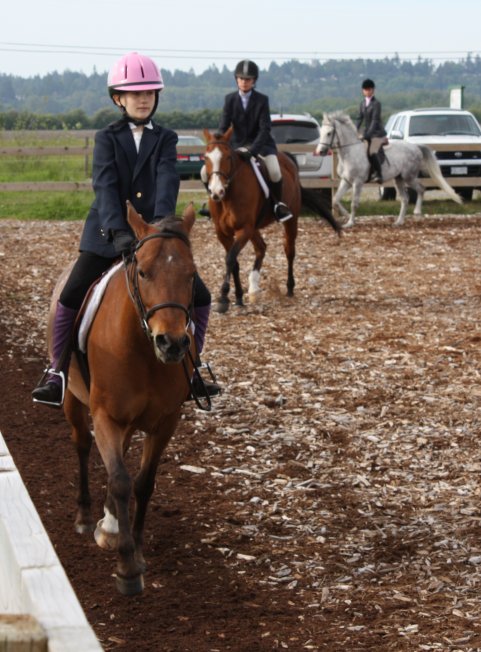Or rather, safety with numbers, is this week's topic. In other words, how do you
14. Identify and maintain safe distance in group while riding and halted
It's not enough to simply maintain the pace and direction of your own mount in relation to the fixed objects in the ring; you also need to be able to adjust your position in relation to other riders. This applies to shows, lessons, and general group riding. For level one you are not expected to ride your horse into combat interactions, which obviously require much closer spacing.
The Danger Zone
Horses are herd animals and prefer to be near one another, which means they will tend to clump together given their druthers. However some horses have larger 'personal bubbles' than others and will kick, bite or shoulder aside horses that crowd them. To avoid being kicked, always keep at least one horse length back from the rider in front of you, pass with a horse-length between you, and come back to the rail a horse-length in front.
The Speed Factor
Except in precision drill team work, there's seldom a time when all horses in the ring move at the same speed. This means your horse may catch up to the one in front of you. When this happens you have several options.
- Slow down to match the pace of the horse in front. This is probably the hardest option, especially if you are a beginning rider. It may also ruin the gait you are trying to work on or demonstrate in a lesson or show.
- Pass on the inside, if there are no obstacles (such as jumps on the quarterline) in the way. Only pass if you are considerably faster than the other horse. If your horse is only slightly faster you may spend too much time riding side by side, which means the instructor or judge has an obstructed view of the outside horse.
- Make a 20m circle, which eats up time and allows you come back to the rail further behind the lead horse. This is a good option for horses that are close to the same speed but have become clumped together.
- Cut across the ring, for example from B to E. This is usually the best choice as it completely removes you from the pack and takes you to a open part of the ring to work freely.
- Halt or transition to a slower gait. This is a last resort as it will cost you marks in the show ring, but sometimes due to obstacles in the ring and other riders crowding you, you may have no choice. And it's always better to break the gait than collide with or be kicked with the horse in front of you!
Think ahead
A good rider always has her eyes up, watching what's going on in the ring. See what horses are acting up or pinning their ears and avoid them. Horses that are prone to kick should wear a red ribbon in their tails, but to be on the safe side, consider all horses potential kickers and ride accordingly. If an instructor or judge asks for an up transition and you are in a crowd of riders you won't lose marks for waiting till the other riders have moved off -- rather you will gain them for showing good ring sense.
Getting Closer
As you work your way toward combat interactions, notice your horse's personality. Does he pin his ears when another horse approaches? A biter is more prone to turn towards a horse he doesn't like; a kicker is more likely to swing her haunches towards an unfriendly horse. Even the most submissive and quiet horse has defensive reactions and you will benefit by becoming aware of them now in order to work around them later.
For those of you who want to keep up your riding over November and December I am available for some private and semi private lessons. Email me at jennifer@academieduello.com for rates and availability. Jack, Flavie and Princess are also available for single day leases for those with Riding Level 2 and above.
If the weather keeps you indoors you can read your Manual of Horsemanship (a few copies are available in the store). I have gathered an archive of earlier blog posts that I'm still building with articles on various stable management and riding topics. Stay warm, stay dry, and keep riding!
